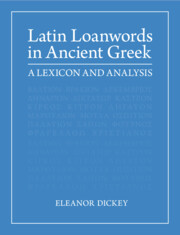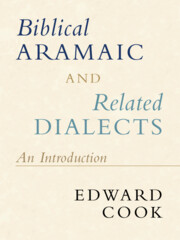Refine search
Actions for selected content:
49 results
1 - Lyric as Literature
- from Part I - Imperial Phenomenology of Lyric
-
- Book:
- Aelius Aristides and the Poetics of Lyric in Imperial Greek Culture
- Published online:
- 01 May 2025
- Print publication:
- 15 May 2025, pp 25-63
-
- Chapter
- Export citation
6 - The City and Its Records
-
- Book:
- The Idea of the City in Late Antiquity
- Published online:
- 30 January 2025
- Print publication:
- 27 February 2025, pp 196-235
-
- Chapter
- Export citation
2 - The Local Clergy and “Ties of Indebtedness” in Abbasid Egypt: Some Reflections on Studying Credit and Debt in Early Islamicate Societies
- from Part I - Personal ties
-
-
- Book:
- Mechanisms of Social Dependency in the Early Islamic Empire
- Published online:
- 06 December 2024
- Print publication:
- 28 November 2024, pp 60-104
-
- Chapter
-
- You have access
- Open access
- Export citation
7 - The Epistolary Imamate: Circular Letters in the Administration of the Shiʿi Community
- from Part II - Institutions
-
-
- Book:
- Mechanisms of Social Dependency in the Early Islamic Empire
- Published online:
- 06 December 2024
- Print publication:
- 28 November 2024, pp 206-231
-
- Chapter
-
- You have access
- Open access
- Export citation
4 - Aloneness as Connector in Arabic Papyrus Letters of Request
- from Part I - Personal ties
-
-
- Book:
- Mechanisms of Social Dependency in the Early Islamic Empire
- Published online:
- 06 December 2024
- Print publication:
- 28 November 2024, pp 127-149
-
- Chapter
-
- You have access
- Open access
- Export citation
8 - Soldiers’ Wives en Route in Roman Egypt
-
-
- Book:
- Women and the Army in the Roman Empire
- Published online:
- 24 October 2024
- Print publication:
- 07 November 2024, pp 219-239
-
- Chapter
- Export citation
The End of Tutela Mulierum
-
- Journal:
- The Journal of Roman Studies / Volume 114 / November 2024
- Published online by Cambridge University Press:
- 14 November 2024, pp. 85-103
- Print publication:
- November 2024
-
- Article
-
- You have access
- Open access
- HTML
- Export citation
First Corinthians 6.1–6: Roman Court or Private Arbitration?
-
- Journal:
- New Testament Studies / Volume 70 / Issue 2 / April 2024
- Published online by Cambridge University Press:
- 03 June 2024, pp. 160-173
- Print publication:
- April 2024
-
- Article
-
- You have access
- Open access
- HTML
- Export citation
5 - Ptolemaic Egypt
-
- Book:
- Slavery and Dependence in Ancient Egypt
- Published online:
- 01 March 2024
- Print publication:
- 21 March 2024, pp 211-273
-
- Chapter
- Export citation
As clear as Herculaneum mud: a plea for clarity
-
- Journal:
- Journal of Classics Teaching / Volume 25 / Issue 49 / Spring 2024
- Published online by Cambridge University Press:
- 23 August 2023, pp. 65-66
-
- Article
-
- You have access
- Open access
- HTML
- Export citation
Chapter 2 - The Emperor As an Arbiter of Justice
-
- Book:
- Imagining the Roman Emperor
- Published online:
- 27 July 2023
- Print publication:
- 10 August 2023, pp 62-98
-
- Chapter
- Export citation
5 - How were Latin loanwords accented in Greek?
-
- Book:
- Latin Loanwords in Ancient Greek
- Published online:
- 25 May 2023
- Print publication:
- 15 June 2023, pp 533-542
-
- Chapter
- Export citation

Latin Loanwords in Ancient Greek
- A Lexicon and Analysis
-
- Published online:
- 25 May 2023
- Print publication:
- 15 June 2023
6 - Recovering the Bodies of Archilochus’ Cologne Epode and Timotheus’ Persae
- from Part II - Texts
-
- Book:
- Greek Poetry in the Age of Ephemerality
- Published online:
- 02 June 2023
- Print publication:
- 27 April 2023, pp 195-217
-
- Chapter
- Export citation
Introduction
-
- Book:
- Athletes and Artists in the Roman Empire
- Published online:
- 02 February 2023
- Print publication:
- 09 February 2023, pp 1-16
-
- Chapter
- Export citation
Chapter 7 - Anatomical Texts of the Roman Period
- from Part II - Text
-
- Book:
- Dissection in Classical Antiquity
- Published online:
- 18 November 2022
- Print publication:
- 08 December 2022, pp 216-273
-
- Chapter
- Export citation

Biblical Aramaic and Related Dialects
- An Introduction
-
- Published online:
- 08 September 2022
- Print publication:
- 29 September 2022
-
- Textbook
- Export citation
8 - Mudbricks and Papyri from the Desert Sand
-
-
- Book:
- Housing in the Ancient Mediterranean World
- Published online:
- 08 July 2022
- Print publication:
- 21 July 2022, pp 261-299
-
- Chapter
- Export citation
9 - Housing and Community
-
-
- Book:
- Housing in the Ancient Mediterranean World
- Published online:
- 08 July 2022
- Print publication:
- 21 July 2022, pp 300-321
-
- Chapter
- Export citation
Titles in the New Testament Papyri
-
- Journal:
- New Testament Studies / Volume 68 / Issue 2 / April 2022
- Published online by Cambridge University Press:
- 04 March 2022, pp. 156-171
- Print publication:
- April 2022
-
- Article
-
- You have access
- Open access
- HTML
- Export citation
